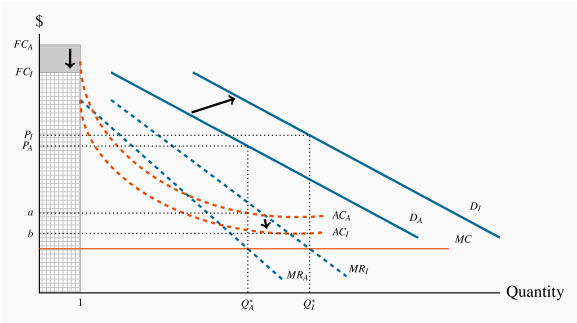The communications revolution has impacted market structure in modern economies profoundly: it has facilitated economies of scope, meaning that firms may yield more collective profit if merged than if operating independently.
Economies of Scope
Imagine an aspiring entrepreneur who envisages a revolution of the traditional taxi sector of the economy. He decides to develop a smartphone application that will match independent income-seeking vehicle owners (drivers) with individuals seeking transport (passengers) from point A to point B. We know how this adventure evolves. In one case it takes the form of the corporation Uber, in another the corporation Lyft, and others worldwide.
These corporations have grown in leaps and bounds and have taken business from the conventional taxi corporations. As of 2019 they cannot turn a profit, yet the stock market continues to bet upon future success: investors believe that when these corporations evolve into fully integrated multi-product suppliers, both costs will decline and demand will increase for each component of the business. In the case of transportation companies, they aim to become a 'one-stop-shop' for mobility services. Uber is not only a ride-hailing service, it also transports meals through its Uber-eats platform, and is developing the electric scooter and electric bike markets in addition. In some local markets it is linked to public transport services. All of this is being achieved through a single smartphone application. The objective is to simplify movement for persons, by providing multiple options on a variety of transport modes, accessed through a single portal.
This phenomenon is described in Figure 11.3. The subscripts A and I represent market conditions when the service supplier is operating Alone or in an Integrated corporation. The initial equilibrium is defined by the A demand and cost conditions. The profit maximizing output occurs when  , leading to a price
, leading to a price  and a quantity
and a quantity  . Each unit of the good yields a profit margin of
. Each unit of the good yields a profit margin of  .
.
This firm now merges with another transportation corporation - perhaps a food delivery service, perhaps an electric bike service. Since each firm has a similar type of fixed cost, these costs can be reduced by the merger. In technical terms, the merged firms, or merged operations, share a common hardware-cum-software platform. Each firm will therefore incur lower average costs, even if marginal costs remain unchanged: the AC curve declines to  . In addition to the decline in average costs, each firm sees an increase in its customer base, because transportation service buyers find it preferable to choose their mode of transport through a single portal rather than through several different modes of access. This is represented by an outward shift in the demand curve for vehicle rides to
. In addition to the decline in average costs, each firm sees an increase in its customer base, because transportation service buyers find it preferable to choose their mode of transport through a single portal rather than through several different modes of access. This is represented by an outward shift in the demand curve for vehicle rides to  .
.
The new profit maximizing equilibrium occurs at  Total profit necessarily increases both because average costs have fallen and the number of buyers willing to buy at any price has risen. The analytics in this figure also describe the benefits accruing to the other firm or firms in the merger.
Total profit necessarily increases both because average costs have fallen and the number of buyers willing to buy at any price has risen. The analytics in this figure also describe the benefits accruing to the other firm or firms in the merger.
A platform describes a technology that is common to more than one product in a multi-product organization.
We conclude from this analysis that, if scope economies are substantial, it may be difficult for stand-alone firms specializing in just one component of the transportation services sector to remain profitable. It may also be impossible to define a conventional equilibrium in this kind of marketplace. This is because some conglomerate firms may have different component producers in their suite of firms. For example, Lyft may not have a food delivery service, but it may have a limousine or bus service. What is critical for an equilibrium is that firms of a particular type, whether they are part of a conglomerate or not, be able to compete with corresponding firms. This means that their cost structure must be similar.
As a further example: Amazon initially was primarily an on-line book seller. But it expanded to include the sale of other products. And once it became a 'market for everything' the demand side of the market exploded in parallel with the product line, because it becomes easy to shop for 'anything' or even different objects on a single site. Only Walmart, in North America, comes close to being able to compete with Amazon.



